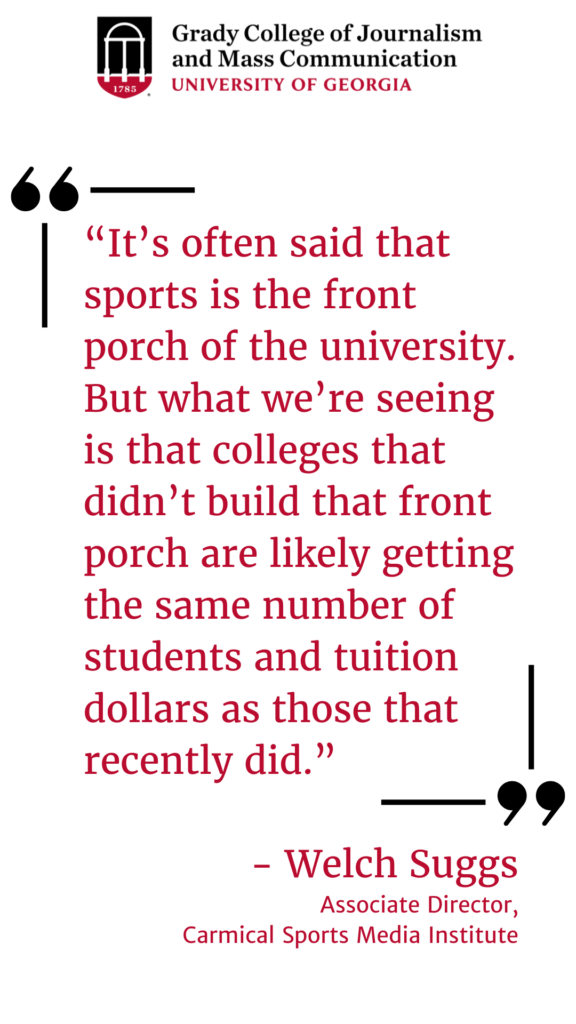Colleges adding football teams do not experience long-term enrollment or tuition advantages, study shows

Colleges adding football teams do not experience long-term enrollment or tuition advantages, study shows
Over the past two decades, numerous colleges have added football teams in a quest to add students, particularly male students, and to use the notoriety of athletics to build their brands. However, new research from UGA’s Carmical Sports Media Institute and the Louise McBee Institute of Higher Education finds that adding a football team does not give a college enrollment or tuition advantages over its peers.
The study, “Institutional Effects of Adding Football: A Difference-in-Difference Analysis,” was published this month in the journal Research in Higher Education. Authors Welch Suggs, Alex Monday, Jennifer May-Trifiletti and James C. Hearn used a difference-in-difference analysis to compare NCAA member institutions that added football to peers that never had the sport.

Colleges that added football saw a modest one- or two-year spike in overall enrollment around the time of adding football compared to other institutions. After that, those gains became statistically indistinguishable from other institutions. The same trend could be found in male enrollment and the enrollment of Black students. Moreover, colleges adding football never realized a statistically-significant increase in tuition revenue per student, according to the analysis.
The study used data from the NCAA and the U.S. Department of Education to compare the fortunes of 36 football-adding colleges to their peers that did not add a football program during the same period. Much of the statistical modeling and analysis was done by Monday and May-Trifiletti, graduate students at the McBee Institute.
“This is the closest we can come to saying, what would have happened to a college if it never added football?” said Suggs, lead author of the study and associate director of the Carmical Sports Media Institute, housed at Grady College. “It’s often said that sports is the front porch of the university. But what we’re seeing is that colleges that didn’t build that front porch are likely getting the same number of students and tuition dollars as those that recently did.”
A particular college might well have seen an enrollment boost since adding football, but it also might have taken several other steps at the same time, such as awarding more merit scholarships or adding other activities to attract students. This study could not take these factors into account at each of the institutions under consideration.
The findings are particularly relevant at a time when many colleges are facing significant enrollment challenges. The college-going population is shrinking and institutions are facing a particular challenge beginning in 2026 because of a decline in birth rates during the Great Recession. This study suggests that adding a football team is unlikely to give a college advantages over its competitors for increasingly scarce students.
Evaluating the costs and benefits of adding football requires considering other factors, says Suggs. The number of high school football players nationwide has declined somewhat amid concerns about concussions and long-term impacts on health and safety, although those numbers rebounded in 2023. Football also requires much higher investments in equipment, facilities and staff than most other college sports.
This research had its origins in a project that the co-authors completed under contract for the Council of Independent Colleges in 2020. That study had similar findings for members of the CIC.
“As always, this study raises more questions than it answers,” Suggs said. “Football has become a big deal at many colleges that added the sport recently. What separates the ones that have prospered from the ones that haven’t? What does a successful enrollment strategy look like? What role can shifts in athletic programming play in effective adaptation to emerging challenges facing institutions?”
The co-authors hope to employ new data and methods to explore these increasingly significant questions.
The article’s formal citation: Suggs, W.; Monday, A.B.; May-Trifiletti, J.; and Hearn, J.C. (2024). “Institutional Effects of Adding Football: A Difference‑in‑Difference Analysis.” Research in Higher Education. https://doi.org/10.1007/s11162-024-09786-7 An unpaywalled copy can be found at https://rdcu.be/dE36O.
For more information, please contact Welch Suggs at wsuggs@uga.edu and @welchsuggs on most social platforms.